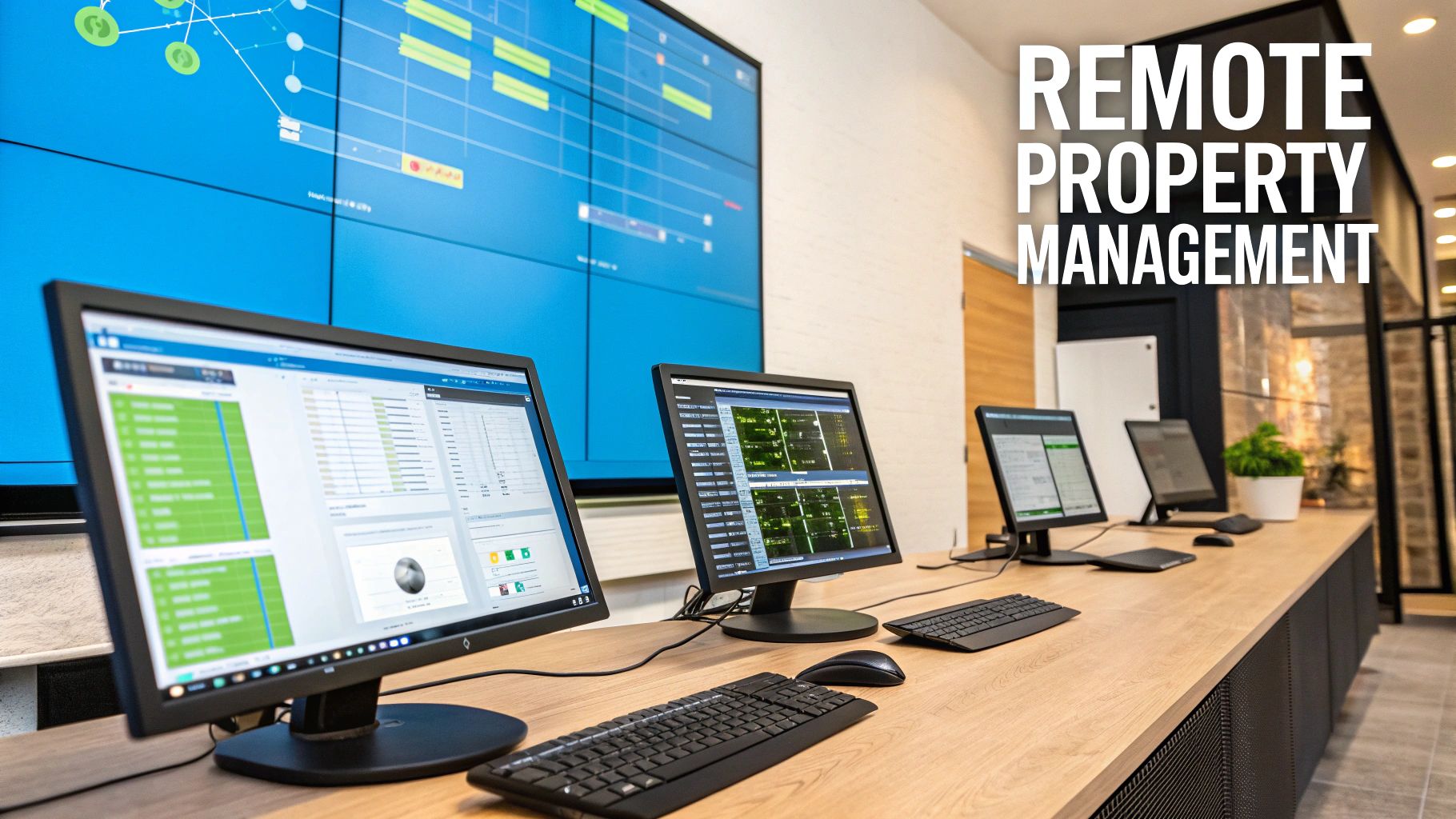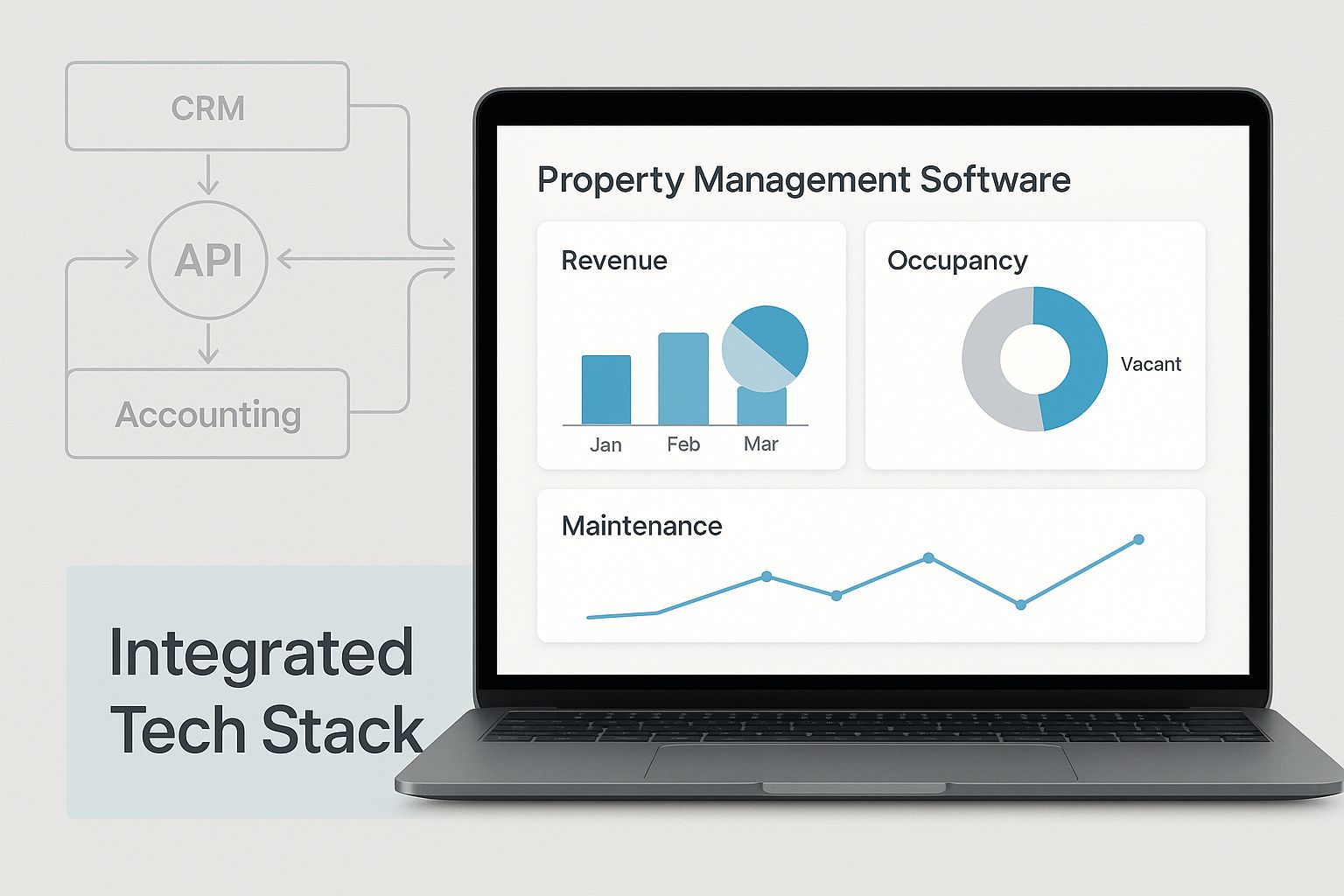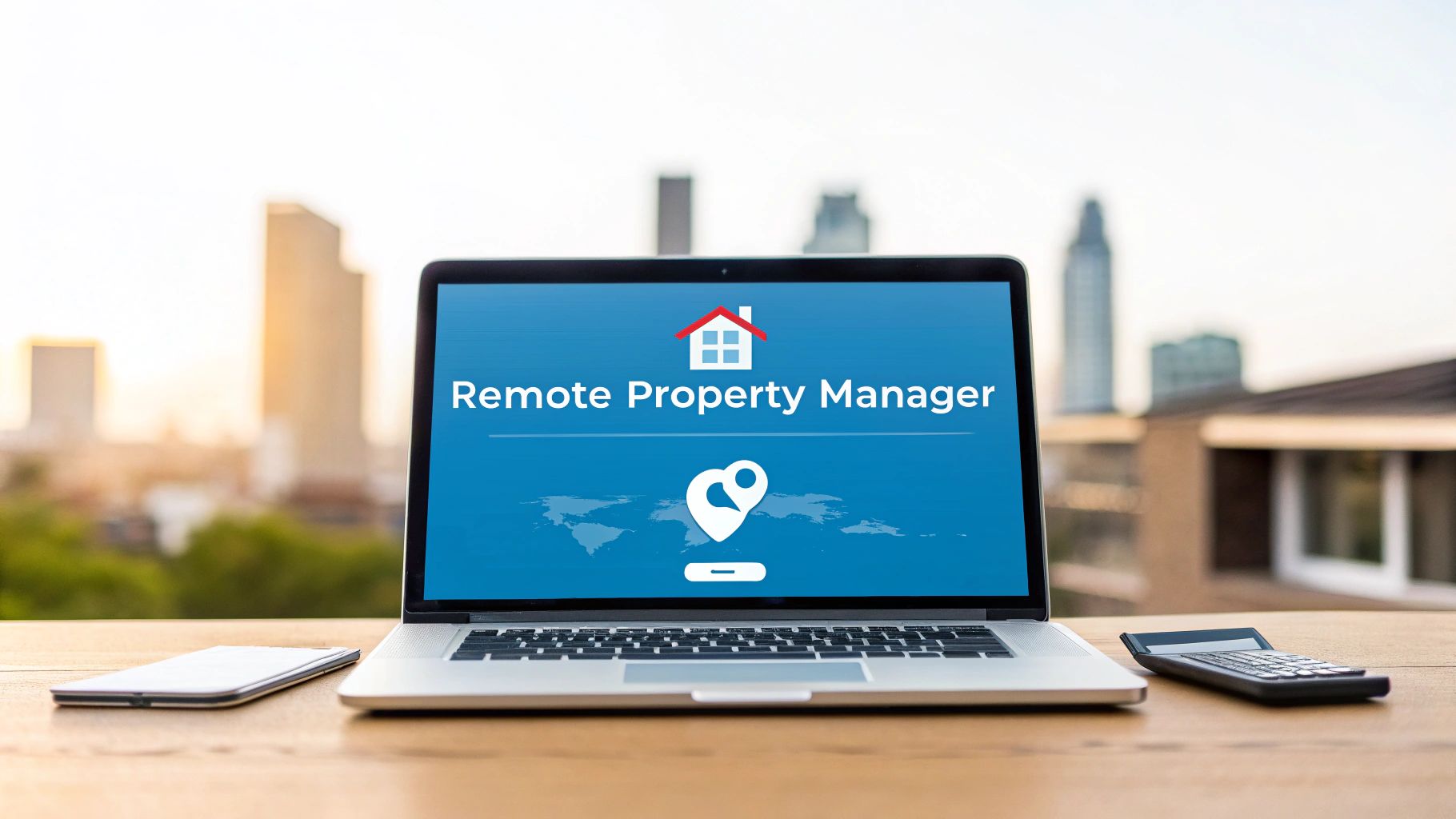For large-scale portfolio managers, the term remote property manager no longer means an individual working from a home office. It represents a strategic shift to a centralized operational model—a command center that leverages technology and on-demand field resources to manage thousands of geographically dispersed rental units without requiring dedicated onsite staff.
The New Operational Standard for Enterprise Property Management

The days of needing an onsite manager for every multifamily building or a dedicated local agent for each cluster of single-family rentals are over. For property management companies managing 1,000+ units, the primary competitive advantage now lies in mastering remote operations at scale. This is a fundamental move away from a fragmented, market-by-market approach toward a powerful, unified system that drives efficiency and accelerates revenue.
This isn't a temporary trend; it’s a structural evolution in property management business design, mirroring the broader shift toward remote-first models seen in the future of remote work. For managers of large portfolios, this model is the key to unlocking a level of operational efficiency and speed-to-lease that was previously unattainable.
Shifting from Local Silos to Centralized Command
The core principle is to replace manual, location-dependent tasks with scalable, technology-driven workflows. This empowers a lean central team to oversee all critical leasing and management functions across an entire portfolio, regardless of geographic distribution. The ROI is clear and immediate:
- Drastically Reduced Operational Overhead: Eliminating multiple physical offices and redundant administrative staff significantly lowers the cost per door. For a 1,000-unit portfolio, this can translate into six-figure annual savings.
- Accelerated Leasing Cycles: Automation tools engage new leads 24/7 and enable immediate, on-demand tour scheduling. The direct result is a measurable reduction in Days on Market (DOM)—the most critical revenue metric for any portfolio.
- Standardized Quality Control: Centralized systems ensure every property and prospect receives a consistent, high-quality experience. This protects brand reputation and standardizes performance across all markets.
This transformation is critical for growth. With 92% of third-party property management companies planning portfolio expansion in 2024 and 2025, adopting remote-friendly, scalable solutions is no longer optional. Understanding the future of property management is essential for staying competitive at scale.
Your Enterprise Blueprint for Remote Operations
A high-performing remote operation is not an accident—it’s engineered. For any property manager overseeing hundreds or thousands of units, this requires a scalable framework built on three pillars: Technology, Process, and People. This blueprint transforms the concept of remote management from an idea into a revenue-generating, high-efficiency reality.
Attempting to manage a distributed portfolio without this structure is like trying to scale without a system. You might handle 100 doors, but at 1,000, the cracks appear. A robust blueprint ensures every action—from initial lead response to maintenance dispatch—is executed with precision and consistency across every asset.
The Three Pillars of Scalable Remote Management
1. Technology: The Engine of Efficiency & Speed
The foundation of any enterprise remote operation is its PropTech stack. This isn't about collecting disparate apps; it's about building an integrated ecosystem. A robust Property Management System (PMS) serves as the central database, but the key to reducing DOM is specialized leasing automation software. Tools that automate tour scheduling, pre-qualify leads, and provide on-demand access are non-negotiable for minimizing vacancy loss.
2. Process: The Playbook for Quality Control at Scale
Technology is only as effective as the processes guiding it. Every critical workflow—from lead nurturing to unit turnover—must be documented, standardized, and automated wherever possible. This guarantees that whether a unit is in Denver or Dallas, the operational steps and tenant experience are identical. This is crucial for protecting your brand and minimizing errors. When creating your playbook, standardize key processes like turnover using resources such as a comprehensive end-of-tenancy cleaning checklist.
A standardized process is the secret to quality control at scale. It eliminates guesswork and empowers your team to execute tasks with confidence, ensuring a predictable, positive outcome that directly impacts your lead-to-tour conversion rates and reduces costly vacancy days.
3. People: The Hybrid Human Infrastructure
Finally, a remote model redefines your team structure, shifting from siloed onsite staff to a more dynamic, hybrid model:
- A Centralized Hub: A core team of operations coordinators manages all communications, scheduling, and system oversight from a central location.
- An On-Demand Field Network: A flexible network of licensed agents and vetted vendors is dispatched for specific, on-the-ground tasks like agent-led showings, inspections, and maintenance.
This hybrid approach provides the essential boots-on-the-ground coverage without the fixed overhead of full-time, market-specific employees. It’s the optimal blend of centralized control and localized execution, creating a lean, powerful operational machine built for scale.
Your Technology Stack for Remote Success
For a property manager running a remote or distributed portfolio, technology is the central nervous system of the operation. It's not a collection of apps but an integrated machine engineered for speed, scale, and efficiency. This is what enables a lean central team to manage thousands of units across multiple markets without losing control.
The goal is to create a frictionless journey from lead to lease. This begins with tools that automate tour scheduling and provide on-demand showing options, allowing prospects to book a tour the moment their interest is highest. When combined with smart lock technology for secure, self-guided tours, you eliminate the scheduling friction that adds days—or even weeks—to your vacancy period.
Core Components of a Scalable Tech Stack
The most effective remote operations are built on a foundation of integrated tools. Each component serves a specific function to accelerate the leasing funnel and reduce manual workload.
- Property Management System (PMS): Your system of record and central database for all property and tenant data.
- Automated Tour Scheduling: Platforms like Showdigs qualify leads and book showings 24/7, ensuring no lead goes cold waiting for a human response.
- Smart Lock Technology: Provides secure, trackable access for self-showings, dramatically expanding showing availability without adding headcount.
- AI-Powered Communication: Automated text and email follow-ups keep prospects engaged throughout the leasing journey, improving lead-to-tour conversion.
The infographic below illustrates how these components connect to form a powerful, unified leasing engine.

As shown, the real power is unlocked when API integrations create a seamless data flow, providing a real-time, portfolio-wide view and eliminating disconnected data silos.
Driving Real ROI Through Integration
The strategic advantage comes from connecting your showing platform, PMS, and communication tools via API integrations. This creates a closed-loop system where data flows automatically, eliminating manual data entry and providing real-time performance insights. For any modern remote property manager, this level of automation is an operational necessity.
A staggering 75% of real estate professionals now use digital platforms to communicate with clients. More importantly, property managers who adopt an integrated tech stack report operational cost reductions of up to 40%. This shift isn’t just about internal efficiency; it's about meeting modern renter expectations for a seamless, on-demand digital experience. For more on this, see the latest real estate trends on Spinify.com.
The following table highlights the financial and operational impact of an integrated system.
Comparing Remote Operations Manual vs Automated Systems
An integrated stack is a game-changer, directly improving your most critical KPIs, from lead-to-tour conversion rates to your ultimate speed-to-lease.
To dive deeper, see our complete guide on marketing automation for your leasing tech stack.
Optimizing Your Remote Leasing Funnel to Reduce DOM
How do you accelerate the leasing cycle when your team is managing properties from hundreds of miles away? The key is to optimize every stage of the remote leasing funnel into a high-velocity machine that converts leads into signed leases faster. For a large-scale remote property manager, this is a core strategy for maximizing portfolio revenue by minimizing vacancy loss.
The entire funnel must be engineered to eliminate friction and delays. This starts the moment a lead inquires, with instant, automated responses ensuring no prospect goes cold. Your system should immediately engage, pre-qualify, and present flexible options for viewing the property.
Offer Flexible and On-Demand Showings
To dominate a market remotely, you must cater to the modern renter's expectations for immediate gratification. The traditional 9-to-5 appointment block is obsolete. A multi-option viewing strategy is essential to capture every qualified lead.
- Self-Guided Tours: Using smart lock technology, you empower vetted prospects to tour properties on their own schedule—mornings, evenings, and weekends.
- On-Demand Agent Tours: For prospects who prefer a human touch, platforms like Showdigs dispatch a local, licensed agent from a vetted network to conduct a tour, often on the same day.
This hybrid approach ensures maximum showing availability, which dramatically improves your lead-to-tour conversion rate.
By combining self-showings with an on-demand agent network, property managers can increase their showing availability by over 300% compared to traditional methods. This directly translates into more tours, faster applications, and a significant reduction in vacancy days.
This speed has a massive impact on your bottom line. Consider a 1,000-unit portfolio with an average rent of $2,000/month (approximately $67/day per unit). Shaving just five days off your average Days on Market (DOM) across the portfolio recovers over $335,000 in annual revenue. That is the financial power of an optimized remote leasing funnel.
Assembling Your On-Demand Field Team

Let’s clarify a critical point: successful remote management doesn’t mean no one is on the ground. It means having the right people on the ground at the right time, without the crushing overhead of a full-time, geographically-dispersed field staff.
This is where an on-demand model becomes a strategic imperative for any large-scale portfolio.
Instead of hiring W-2 employees in every market, a modern remote property manager leverages a flexible network of licensed agents and vendors. This provides the essential boots-on-the-ground coverage for showings, inspections, and move-ins with the agility to scale based on leasing velocity. It’s a powerful human infrastructure that supports a lean central operation.
Building a Scalable Field Network
Executing this model across thousands of units requires a disciplined combination of clear standards and technology. You aren't just hiring gig workers; you are extending your brand into new markets. Success demands a robust framework.
- Set Clear Performance Standards: Every agent must understand your brand's expectations for professionalism, communication, and property presentation. This includes everything from greeting prospects to submitting detailed post-tour feedback.
- Use Technology for Dispatch and Monitoring: A central platform is essential for assigning tasks, tracking progress in real-time, and receiving standardized field reports. This ensures consistency and accountability across your entire portfolio.
- Implement Robust Quality Control: Utilize prospect feedback surveys and agent performance scorecards to monitor quality continuously. This data allows you to reward top performers and provide targeted coaching, ensuring a premium experience for every lead.
By leveraging a managed network of on-demand agents, property management companies can achieve 100% tour coverage across multiple markets without adding a single person to their payroll. This model directly slashes operational costs and reduces Days on Market (DOM).
This approach transforms your field operations from a fixed cost center into a variable, performance-based expense, enabling rapid and efficient expansion into new markets.
Once you master managing a distributed team, you unlock true operational scalability.
Tracking KPIs for Scalable Growth
If you can't measure it, you can't manage it—and you certainly can't scale it. For large-scale remote property management, this principle is absolute. To drive profitable growth, you must move beyond vanity metrics and focus on the Key Performance Indicators (KPIs) that directly link operational actions to financial outcomes.
Without a centralized dashboard displaying real-time data, you are managing blind. You won't identify a rising DOM in a specific market or replicate a high-performing process across your portfolio. Data-driven decision-making is the only way to scale sustainably and optimize your cost per door.
Core KPIs for Remote Leasing Operations
Your operational dashboard must spotlight the core metrics that connect leasing activities directly to the bottom line. These are the numbers that tell the real story of your portfolio's health.
- Cost Per Showing: The true all-in cost to get a prospect through the door, including marketing spend, agent fees, and technology costs.
- Lead-to-Tour Conversion Rate: A direct measure of how effectively your automated systems convert initial interest into a physical tour. This KPI is a critical indicator of front-end funnel health.
- Cost Per Lease: The ultimate metric. This calculates the total expenditure from initial ad to signed lease, providing a clear picture of tenant acquisition cost (TAC).
Expanding Metrics to Asset Value
Effective remote management extends beyond leasing KPIs. The best remote technology also helps monitor asset performance, especially regarding sustainability upgrades that reduce operating expenses and enhance property value.
For example, data shows that energy-efficient buildings can command rent premiums of up to 7%. By retrofitting properties with smart technology like IoT sensors for predictive maintenance, buildings can reduce energy consumption by 20-30%. Those savings directly improve Net Operating Income (NOI) and increase the asset's overall valuation. To learn more about where the industry is heading, check out this article on the future of property management on RentCaps.com. This holistic view is what separates a good remote manager from a great one.
Ready to gain real-time control over your remote leasing operations? Showdigs provides the centralized dashboard and on-demand field network you need to track the KPIs that matter, slash your Days on Market, and scale your portfolio with confidence. Schedule a demo today and see how we transform remote property management.







